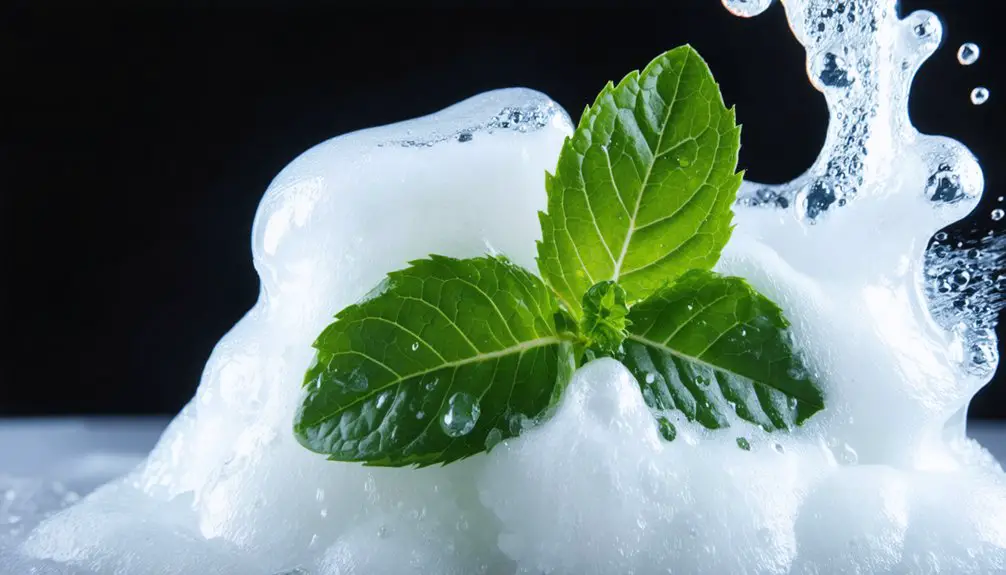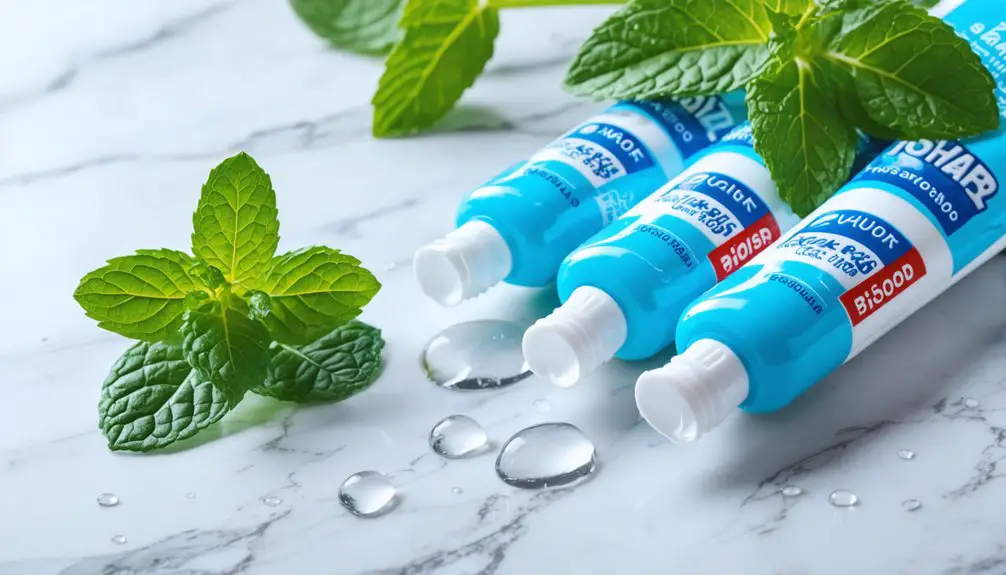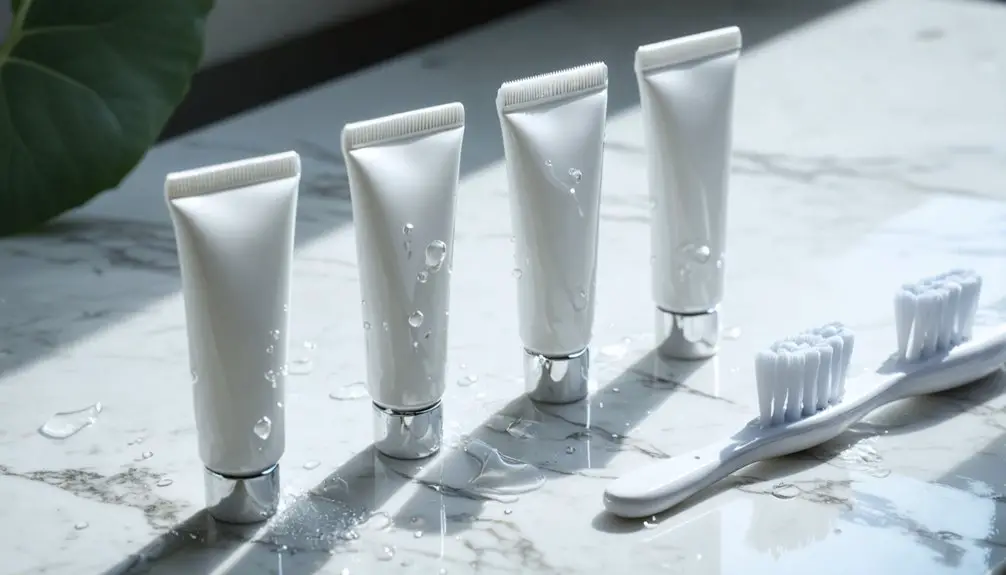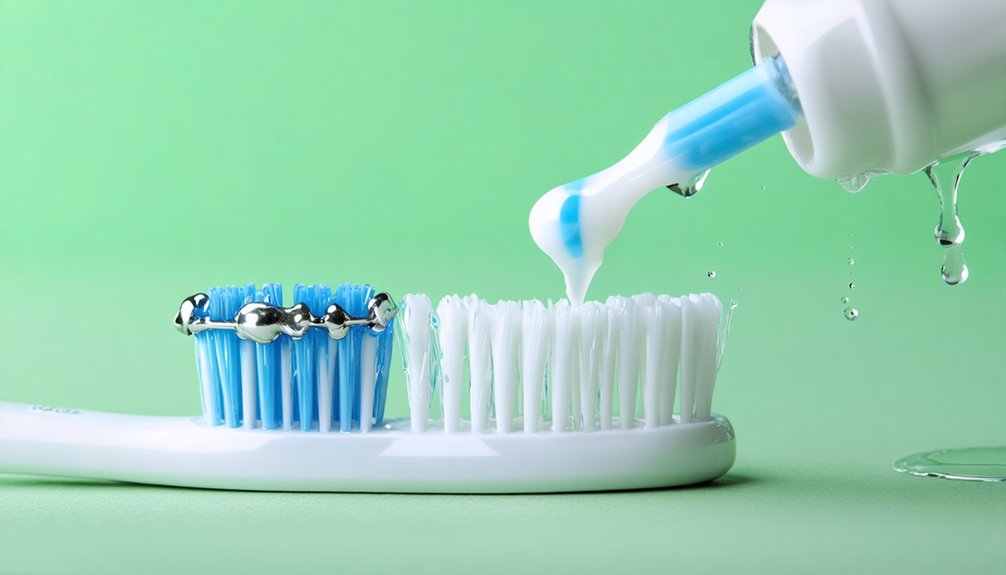Your whitening toothpaste improves breath freshness through multiple mechanisms working simultaneously. The abrasive agents remove surface stains while disrupting bacterial plaque that causes bad breath. Chemical compounds like baking soda neutralize volatile sulfur compounds and raise oral pH, while enzymatic systems actively break down odor-causing proteins. Additional ingredients such as zinc citrate and essential oils provide antimicrobial properties. Understanding these components reveals how they work together for ideal oral freshness.
Key Takeaways
- Hydrogen peroxide in whitening toothpaste kills odor-causing bacteria while penetrating stains, creating a dual benefit for fresh breath.
- Baking soda neutralizes volatile sulfur compounds and raises oral pH, effectively combating bad breath-causing substances.
- Enzyme systems break down protein compounds causing malodor and enhance saliva’s natural cleansing properties.
- Antitartar compounds like zinc citrate inhibit bacterial growth and neutralize bad breath compounds while preventing gum disease.
- Essential oils and flavoring agents provide immediate breath freshening while offering antimicrobial benefits against odor-causing bacteria.
The Science Behind Whitening Toothpaste and Fresh Breath
While many consumers focus primarily on the aesthetic benefits of whitening toothpaste, the science behind these products reveals a complex interplay between mechanical and chemical processes that simultaneously enhance tooth appearance and breath freshness.
Beyond mere cosmetics, whitening toothpaste combines sophisticated mechanical and chemical processes to improve both dental aesthetics and oral health.
When you brush, abrasive particles like silica and alumina mechanically disrupt surface stains on tooth enamel while creating fresh sensations through polishing action. This smoother surface reduces bacterial adhesion, limiting the growth of organisms that cause bad breath. Regular brushing with whitening toothpaste containing hydrogen peroxide can help penetrate deeper stains while killing bacteria that cause odors.
Chemical agents, such as sodium hexametaphosphate and pyrophosphates, prevent new stain attachment by binding to protein pellicles. These compounds work alongside the mechanical cleaning to maintain a cleaner oral environment. The addition of pure baking soda helps neutralize harmful acids while providing enhanced cleaning power.
The dual approach effectively removes existing stains while creating an unfavorable surface for bacterial colonization, directly addressing two major contributors to oral malodor.
Key Ingredients That Combat Bad Breath
Your whitening toothpaste’s baking soda delivers a triple action of pH neutralization, mechanical plaque removal, and enhanced salivary cleansing to combat odor-causing bacteria.
Advanced enzyme systems in modern formulations break down protein-based compounds that contribute to malodor while simultaneously promoting fresh breath. Essential oils like eucalyptol and thymol provide additional antimicrobial properties to help reduce bad breath.
Regular use of formulas containing activated charcoal helps neutralize persistent bad breath through natural absorption of odor molecules.
Antitartar compounds, including zinc citrate and stannous fluoride, work synergistically to inhibit bacterial proliferation and neutralize volatile sulfur compounds responsible for halitosis.
Baking Soda’s Triple Action
Through its unique triple-action mechanism, baking soda (sodium bicarbonate) effectively combats bad breath by neutralizing volatile sulfur compounds, suppressing bacterial growth, and removing plaque buildup.
When you incorporate baking soda into your oral hygiene routine, you’ll benefit from its chemical neutralization of malodorous compounds and its ability to create an alkaline environment above neutral pH. Since 25-31% of people experience chronic halitosis worldwide, baking soda’s effectiveness is particularly significant.
This higher pH inhibits the enzymatic activity of VSC-producing bacteria while disrupting their biofilm formation. With a pH level of 8.3, baking soda creates an environment where harmful bacteria cannot thrive. Additionally, baking soda’s mild abrasiveness mechanically removes plaque up to three times more effectively in hard-to-reach areas compared to conventional toothpastes.
These baking soda benefits persist throughout the day due to its sustained pH buffering capacity, helping you maintain fresh breath by targeting the root causes of halitosis.
Enzyme-Powered Fresh Breath
Modern enzyme-powered toothpastes represent an advanced biological approach to fresh breath maintenance, complementing the mechanical action of baking soda-based formulations. Clinical investigations have shown significant reductions in plaque and gingival inflammation compared to standard fluoride toothpaste.
The enzyme benefits stem from natural compounds like lactoperoxidase, lysozyme, and lactoferrin that mirror your body’s own oral defense mechanisms. The gentle yet potent action makes enzyme toothpaste ideal for daily oral care.
These specialized enzymes work by catalyzing reactions that produce antibacterial agents, particularly hypothiocyanite, which inhibits bacterial growth. They break down plaque biofilm‘s protective matrix while supporting your oral microbiome’s balance.
The enzymatic action targets volatile sulfur compounds at their source by decomposing food residues that feed odor-causing bacteria. Through continuous activity, even after brushing, enzymes promote sustained freshness by maintaining healthier microbial communities and enhancing your saliva’s natural cleansing properties.
Antitartar Compounds Fight Bacteria
Several powerful antitartar compounds work synergistically to combat breath-causing bacteria in whitening toothpastes.
Cetylpyridinium chloride (CPC), at a 0.07% concentration, actively reduces plaque accumulation while killing bacteria that produce volatile sulfur compounds.
You’ll find zinc compounds providing dual antitartar benefits by binding directly to VSCs and inhibiting bacterial growth on tooth surfaces.
For enhanced bacteria reduction, essential oils like eucalyptol and thymol disrupt bacterial cell membranes, while fluoride strengthens enamel to prevent decay-related bacterial colonization. Maintaining good oral hygiene through consistent use of these ingredients helps prevent gum diseases like periodontitis and gingivitis.
In severe cases, prescription-strength chlorhexidine may be combined with CPC and zinc for maximum efficacy.
This multi-targeted approach guarantees thorough protection against oral bacteria, particularly when you combine these active ingredients with proper brushing and flossing techniques.
How Baking Soda Creates a Fresher Mouth
You’ll find that baking soda’s alkaline properties effectively neutralize acidic compounds in your mouth, creating an environment where harmful bacteria struggle to thrive.
The increased pH level disrupts bacterial metabolism, reducing their ability to produce acids that cause tooth decay and bad breath.
Through its dual action of pH neutralization and bacterial interference, baking soda systematically dismantles plaque formation while supporting fresher breath. The natural antibacterial properties of baking soda help protect against decay while promoting better oral health.
Neutralizes Harmful Mouth Acids
Because baking soda rapidly neutralizes acidic compounds in the oral cavity, it’s particularly effective at creating a less hostile environment for teeth and gums.
When you use baking soda-containing toothpaste, you’re initiating a chemical reaction that quickly raises oral pH balance through acid neutralization. This process occurs through the formation of neutral salts and water, effectively countering the acidic conditions that contribute to enamel erosion and bacterial growth.
Your mouth’s buffering capacity greatly improves with sodium bicarbonate, helping to maintain stable pH levels for up to two hours after exposure.
While baking soda can interact with salivary calcium, potentially affecting remineralization, its immediate impact on neutralizing harmful acids makes it valuable for oral health.
The enhanced buffering action also reduces inflammatory markers and creates an environment less conducive to acid-producing bacteria.
Disrupts Bacterial Plaque Formation
Beyond its acid-neutralizing properties, baking soda demonstrates remarkable effectiveness in disrupting bacterial plaque formation through multiple mechanisms.
When you brush with baking soda toothpaste, its particles act as gentle abrasives that physically disrupt plaque biofilm without damaging enamel. The compound’s high solubility enables rapid penetration through bacterial layers while chemically dissolving the extracellular polymeric substances that bind plaque bacteria together.
Baking soda’s alkaline nature creates an inhospitable environment for plaque-forming bacteria like Streptococcus mutans. This elevated pH not only inhibits bacterial growth but also weakens the plaque matrix structure, making it easier to remove during brushing.
Clinical studies confirm that baking soda dentifrices outperform conventional toothpastes in controlling plaque across all tooth surfaces, including hard-to-reach areas.
Enzymatic Action: Breaking Down Odor-Causing Compounds

While traditional toothpastes rely on chemical agents, enzymatic formulations harness biological catalysts to break down odor-causing compounds through multiple mechanisms.
The LP3 enzyme system deploys lactoperoxidase, lysozyme, and lactoferrin to target bacteria producing volatile sulfur compounds, while proteases actively degrade sulfur-containing substances that cause bad breath. You’ll find these enzyme mechanisms particularly effective as they continue working long after brushing.
The dual action of mutanase and dextranase (MD2 system) disrupts plaque matrix formation, making bacterial biofilms more water-soluble and less adherent to teeth.
This all-encompassing odor reduction approach supports your patients’ oral health by limiting bacterial substrate availability and maintaining a balanced oral microbiome, without relying on harsh antimicrobials that could disrupt sensitive tissues.
Chemical Components That Keep Breath Fresh
The chemical components in whitening toothpaste work synergistically to maintain fresh breath through multiple mechanisms of action.
You’ll find antitartar agents like sodium hexametaphosphate that bind to protein pellicles, preventing bacterial colonization and subsequent breath deterioration.
Sodium bicarbonate’s alkaline properties neutralize acidic compounds while reducing odor-causing bacteria through its mild abrasiveness.
The chemical interactions between surfactants and plaque-disrupting agents enhance breath enhancement by thoroughly dispersing active ingredients throughout your oral cavity.
These components work alongside enzyme-based systems that break down organic deposits and control microbial growth.
When combined with the mechanical action of abrasives, you’re getting an all-encompassing approach to oral care that addresses both surface stains and underlying causes of breath issues through targeted chemical interventions.
The Role of Surface Stain Removal in Breath Freshness
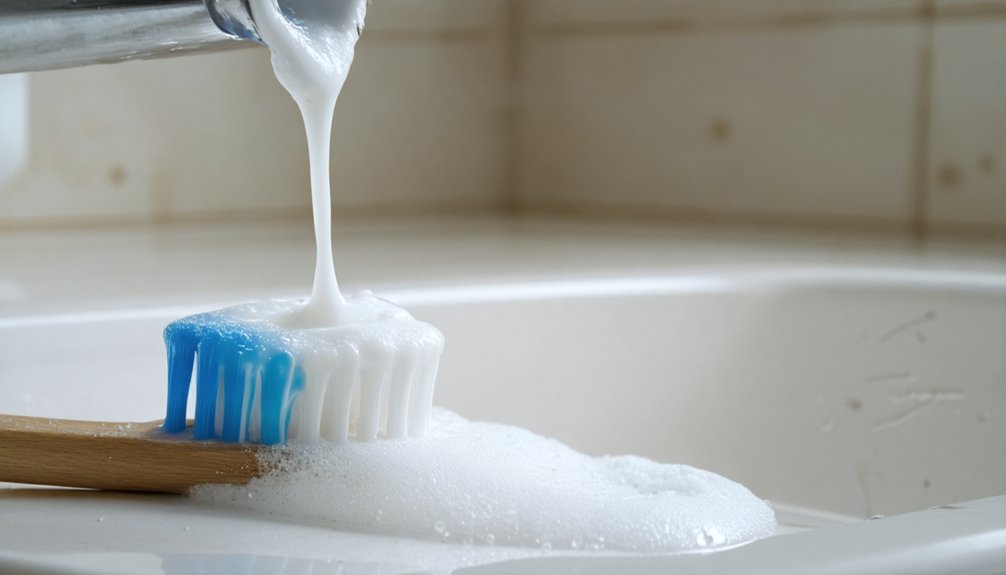
Surface stain removal plays a critical role in maintaining breath freshness through multiple interconnected mechanisms. When you remove surface stains, you’re also eliminating bacterial biofilms and pellicles that produce volatile sulfur compounds responsible for bad breath. The process works by disrupting the environments where odor-causing bacteria thrive.
The removal of extrinsic stains through abrasive action reduces plaque retention and minimizes areas where microorganisms can colonize.
Additionally, whitening toothpaste’s polyphosphates and anti-redeposition agents prevent new stain formation by binding to tooth surfaces and blocking attachment sites. This creates smoother surfaces that are less prone to bacterial accumulation.
As you maintain regular stain control, you’ll notice a correlation between cleaner teeth and fresher breath, as there are fewer substances for bacteria to metabolize into malodorous compounds.
Physical and Sensory Benefits for Long-Lasting Freshness
Modern whitening toothpastes deliver long-lasting freshness through multiple physical and sensory mechanisms working in concert.
When you brush, the physical action removes plaque biofilm where odor-causing bacteria thrive, while flavor enhancement compounds stimulate salivary flow to naturally neutralize bacterial growth.
The dual enzyme technology accelerates the breakdown of food particles and organic matter that contribute to bad breath, while chemical agents bind with proteins that attract bacteria.
Sensory stimulation from mint and essential oils provides immediate cooling effects, with flavor compounds remaining active on your tongue and oral mucosa for extended periods.
You’ll experience sustained antibacterial benefits from ingredients like baking soda, which creates an alkaline environment inhospitable to odor-producing bacteria while supporting the natural oral microbiome balance.
Understanding the Abrasive-Freshness Connection
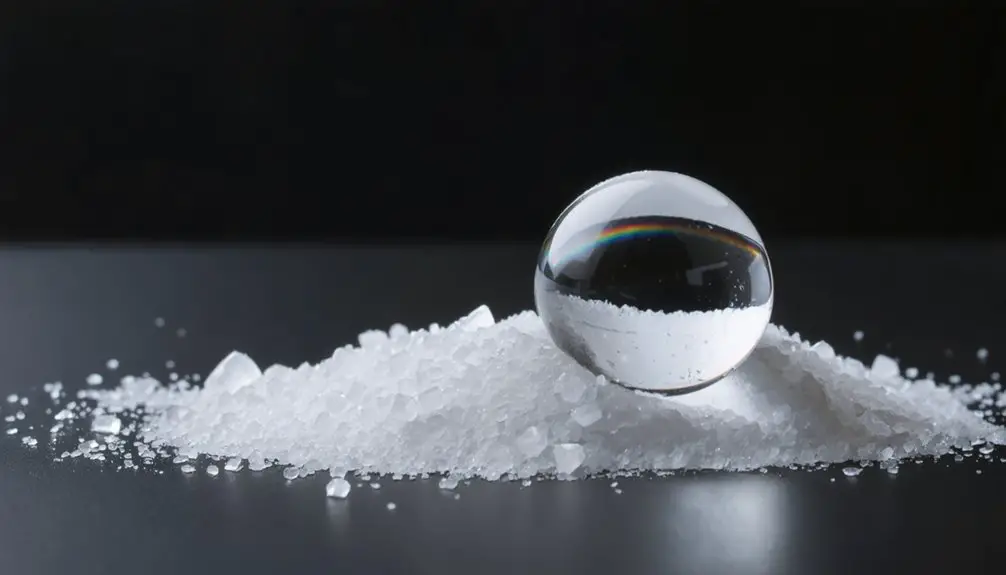
While many consumers focus primarily on whitening effects, abrasive agents in whitening toothpastes play an essential role in maintaining breath freshness through multiple mechanisms.
Common abrasive types like calcium carbonate, hydrated silica, and alumina work through cleaning mechanisms that effectively disrupt bacterial biofilms and remove surface debris. You’ll find these agents mechanically lift stains and food particles that could otherwise contribute to malodor.
The abrasives’ action enhances your saliva’s natural cleansing ability by removing barriers that impede its function.
When you’re using properly formulated whitening toothpaste, the abrasives work synergistically with antibacterial ingredients and flavoring agents. This combination creates an environment that’s less hospitable to odor-causing bacteria while maintaining ideal oral pH balance for sustained freshness.
Safe and Effective Usage for Optimal Results
To maximize the benefits of whitening toothpaste’s dual-action properties, proper usage protocols must be strictly followed.
Following proper usage protocols is essential to unlock the full potential of whitening toothpaste’s dual cleaning and brightening effects.
You’ll need to maintain a whitening frequency of twice daily brushing, with each session lasting a precise two minutes. Monitor your patients for signs of sensitivity or enamel wear, especially during the initial four-week period when results become noticeable.
Advise proper brushing duration using a soft-bristled toothbrush and gentle technique. You’ll achieve superior outcomes by combining the toothpaste with complementary practices like flossing and mouthwash.
Guide patients to avoid brushing immediately after acidic meals and maintain regular dental checkups to assess enamel integrity. For enhanced safety, recommend formulations containing baking soda or hydrated silica rather than peroxide-based agents, particularly for sensitivity-prone individuals.
Frequently Asked Questions
Can Whitening Toothpaste Cause Permanent Tooth Sensitivity While Freshening Breath?
You’ll risk permanent tooth sensitivity if you overuse harsh whitening ingredients, though rare when used properly. Most formulations now include protective compounds while effectively freshening your breath.
How Long Should I Wait After Eating Before Using Whitening Toothpaste?
To protect your tooth enamel from the 48% increased risk of erosion, you’ll need to wait 30-60 minutes after each meal before using whitening toothpaste. Proper meal timing prevents enamel damage.
Does Whitening Toothpaste Work Differently on Natural Teeth Versus Dental Work?
You’ll experience different whitening effectiveness on natural teeth versus dental restorations. While abrasives and enzymes can brighten your natural enamel, they won’t chemically whiten artificial materials in dental work.
Can Children Safely Use Whitening Toothpaste for Breath Freshening?
For children’s dental health, you’ll need to choose safe whitening options, like baking soda-based formulas, and consult a pediatric dentist first. Don’t use whitening toothpaste under age 12.
Will Combining Whitening Toothpaste With Mouthwash Provide Better Breath-Freshening Results?
You’ll achieve enhanced whitening effectiveness and breath control by combining both products, as mouthwash ingredients penetrate deeper areas while toothpaste mechanically removes surface bacteria and stains that cause odors.
References
- https://www.armandhammer.com/en/oral-care/toothpastes/whitening/advance-white-breath-freshening-toothpaste-6-oz
- https://www.healthandbeyond.com/newpro/Whitening-toothpaste-brings-you-white-and-fresh-breath-experience.html
- https://www.sensodyne.com/en-us/products/product-results/extra-fresh-breath-toothpaste/
- https://pmc.ncbi.nlm.nih.gov/articles/PMC9600486/
- https://www.therabreath.com/collections/toothpaste
- https://www.the-independent.com/extras/indybest/fashion-beauty/beauty/best-whitening-toothpaste-uk-reviews-b1783716.html
- https://crest.com/en-us/oral-care-tips/toothpaste/best-whitening-toothpaste
- https://www.parodontax.com/products/parodontax-toothpaste/whitening-toothpaste/
- https://www.parodontax.com/gum-health/maintaining-healthy-gums/mouthwash-ingredients-that-fight-bad-breath/
- https://www.grandvilledental.com/choosing-the-right-toothbrush-and-toothpaste/
